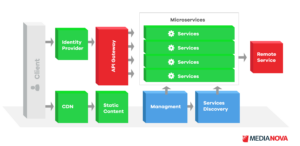How To Enhance Your Microservices At The Edge?
How To Enhance Your Microservices At The Edge?
What Are Microservices?
In any web application, the application architecture helps to define the different application components, and how they interact with one another as well as the user. Over the years, two major architecture styles have become prevalent among web application services; monolithic and microservices architecture.
Monolithic application architecture can be understood as if the application was like a massive container, tightly coupling all the software components.. However, this style has a major disadvantage. Because all the components are so dependent on one another all the associated components must be present in order to compile the code. For example, if one API goes down, then all the other APIs will stop working as well.
Today, for web application services, which have become large and complex, excellent performance is a crucial differentiator. Among other things, the performance depends to a significant extent upon how quickly the web application is responding to requests & how frequently it fails to deliver a response. As a result of helping web application services increase their efficiency and achieve this goal, microservices architecture has become quite popular.
Microservices architecture structures applications as a collection of small, autonomous services. Unlike monolithic architecture, microservices are modular and the different software components are loosely coupled, allowing them to run and scale independently. Microservices are also more scalable, stable, and boost application speed, delivering lower latency to the user.
So How Does a Microservice Architecture Look Like?
In a typical microservice architecture, a routing layer is present, and behind the routing layer, multiple services are running. The routing layer takes all the routes handled by all the individual services and often groups it under a single public domain. The routing layer takes the client request and forwards the call to the appropriate service on the backend.

Microservices at edge use logic at the edge so that it is close to the end-user, and therefore helps deliver a web application service to your users that is robust and fast.
Why Have Microservices Grown In Importance?
By placing logic at the edge in microservices, microservices architecture delivers a web application service that facilitates a good user experience. This results in a more satisfied user, and leads directly to prolonged user engagement and higher conversions.
With companies actively deploying microservices in several enterprise-grade web applications, certain strategies can enhance the overall performance of their microservice architecture and provide a richer content delivery performance to their users.
With microservices at the edge, you can define and deploy logic into your edge server. When the user makes a request, the edge server can respond immediately. The request routing can be done to another edge server if defined. By quickly directing the request to the appropriate backend, it helps to improve the application functionality. Microservices at the edge also increases the server lifetime and uptime by efficiently utilizing the server infrastructure for resolving requests, ultimately reducing the request load on the origin server. With microservices at the edge, web service providers can move their application functionality closer to their users in the network.
Below, we will take a look at specific strategies that web application services can benefit from by supporting their microservices.
How To Increase The Performance of Microservices at The Edge?
- Use a single domain for all the microservices – In a traditional microservice architecture, different components of a web service may be placed on different domains. Thus, when the user requests for the web service on a specific domain, simultaneously, the web service opens up the connections to different domains. In terms of performance, this is slow and expensive – hardly acceptable today. Web requests today are mostly asynchronous, and non-blocking and modern services can place not only applications but also entire database services and even third-party software behind a single domain.
- Map requests to an origin backend – By defining specific rules at the edge, requests can be more efficiently handled and directed to the appropriate backend server. This way, it can be ensured that noisy requests are trimmed and well-formed before they hit the server. Rules can also be defined to take into account the location of the user that is making the request and then direct the request to an appropriate server.
- A/B Testing – While making upgrades to your microservices is vital to keep pace & scale, it is also critical that the user experience does not suffer when making this transition. This can be achieved by defining logics at the edge so that appropriate redirects can be specified when your application is ramping up.
- Remove redundant authentications – With edge services, you can read the authentication cookies at the edge itself and pass this information in HTTP headers. Thus, multiple authentications at each service can be done away with reducing the time it would take for the request to move between the services. You can also make the edge server intelligent in this regard here, by making decisions at the edge itself- to reject inappropriate requests. This will deliver better infrastructure uptime since your server will not have to deal with junk requests.
Closing Thoughts
Microservices have become a key technology strategy for web application services today and as a result more & more mainstream web services are using it to build cutting-edge, flexible and delightful applications. Applications built on the microservices architecture are generally more secure, reliable and stable against bugs than those built using traditional monolithic architecture. By enhancing your microservices at the edge, you can deliver a modern, fast and efficient service that builds your loyal users and grows your bottom-line.




